 George Promenschenkel is about a nine-handicap golfer, but his scorecard can include anywhere from birdies to snowmen. We need to change that – at least the snowmen part. His goal is to become a five handicap and based on his swing, I think he is a lot closer than he realizes.
George Promenschenkel is about a nine-handicap golfer, but his scorecard can include anywhere from birdies to snowmen. We need to change that – at least the snowmen part. His goal is to become a five handicap and based on his swing, I think he is a lot closer than he realizes.
After analyzing his swing I have identified two problems – one which we have seen before and one that we haven’t – which must be dealt with simultaneously.
Read on to see George’s swing and the fixes I’ve outlined for him.
The Swing
George’s swing can be seen here as a QuickTime movie. This shows two angles, at both full speed and quarter speed, both with the driver.
I would highly recommend that you watch the video, identify what you have found as his root problem, and then read on to see if you’re right.
Basic Analysis
My first thought – even before pressing play – is that George should be hitting the ball relatively hard. I looked back to the information that I received from him and was shocked when I saw that he averages about 250 yards. However, after identifying his biggest faults I can see where he is losing a massive amount of power in an effort to gain accuracy.
My job is not to make him more powerful but lose more golf balls. I feel that there is a way that we can give him a simpler way to be accurate AND allow him to utilize his core muscles for power. To accomplish this we are going to move his ball position forward and focus on keeping his leading shoulder behind the ball at impact.
Ball Position and Stance Width
I have said this before, but anytime that I am analyzing a swing with a face-on camera angle the first two things that I check are:
- Ball position
- Stance width
Let’s review what you are looking for using Tiger’s set up.
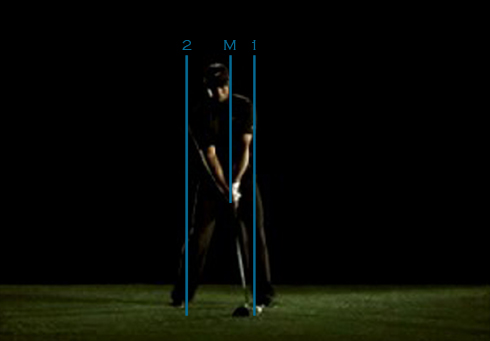
Line 1: Line 1 should run through four separate but equally important places.
- Through the back side of the ball
- Through the back side of your leading heel
- Through the front of your leading hip
- Through the front of your leading shoulder
Line 2: Line 2 should run through two separate but equally important places.
- Through the front of your trailing heel
- Through the back of your trailing shoulder
Line M: This line is a supporting line for Line 1 which crosses through two parts of your body.
- The line should start at the zipper of your pants.
- The line should end at the outside of your leading ear.
Just to prove a little point, I wanted to illustrate that there is a right way and a wrong way to draw Line 1. For the George on the left (below) I drew Line 1 starting at his left heel. For the George on the right I drew Line 1 starting at the backside of the ball. Which one do you think is right?
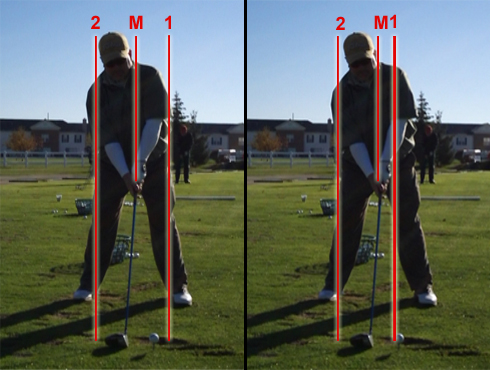
If you chose the George on the right with Line 1 drawn through the backside of the ball you are absolutely correct. This will have a substantial impact on our analysis later on. As you can see, Line 1 is running through the backside of the ball, well behind his leading heel, behind his leading hip, and behind his leading shoulder. Unfortunately, because George’s body is not on the same line as the ball, his body is going to make some pretty dramatic compensating movements to try to hit the ball straight. Anytime you have to make a compensating movement with your body you have to slow down.
So our first, relatively simple change that George is going to need to make is to move the ball forward. This is a hard change to get used to but considering George’s body is already in a pretty solid position it should be a little easier for him. We are not done yet though.
Leading Shoulder at Impact
George is a pretty solid golfer but he has a pretty major set up flaw. As a general rule, if there is one flaw in your swing you will not be able to play well. This must mean that he has something that he is doing to offset his ball position.
We have already gone over how important Line 1 is at set up but I cannot stress enough how critical Line 1 is at impact. In fact, I would argue that even with the incredible amount of variations you will see among tour pro swings – dating as far back as there are videos – there is nothing more consistent than where a player’s leading shoulder will be at impact with their driver.
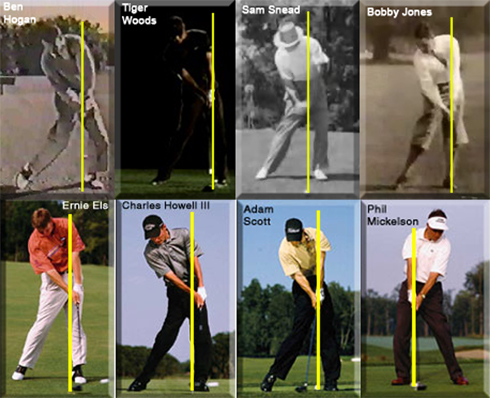
I will spare you the physics of this, but with your driver your leading shoulder must be on or behind Line 1 or you cannot properly hit the golf ball straight. In fact, as soon as your shoulder gets in front of Line 1 the only way that you can come close to hitting the ball straight is to release the club very early on and lose a ton of power. Odds are though that rather than hitting the ball straight, you will end up with a slice or hook and a not very powerful one at that.
There are several moves that George has been making to offset his ball position but pretty much every time you see a low-handicap golfer with a bad ball position you can expect to see a pretty violent move with their leading shoulder as they approach impact. George is in good company – Tiger did this for years.
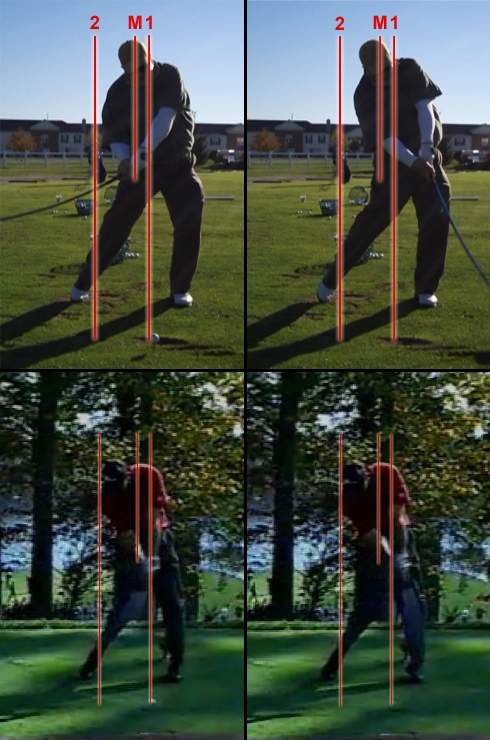
To get to Line 1 both Tiger and George are forcing their bodies to make an incredibly violent motion with their lower body – so much so that Tiger’s left foot literally comes completely off the ground.
Unfortunately, George’s shoulder doesn’t get behind Line 1 and thus, you see him forced to release his hands well before impact. This move has massive consequences for your back and also can prevent you from using your core muscles to produce power. More importantly, it is very hard to consistently make this major adjustment at high speeds. If you are noticing consistency problems with your driver, this is always a good place to check first.
Let’s look at how Tiger’s new swing impact position looks and compare it to his old one.
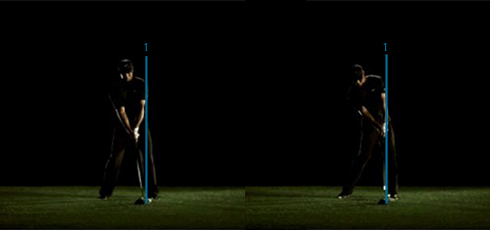
It is hard to ignore just how different Tiger’s impact position looks now. His left foot is firmly planted in the ground, his body is behind the ball, he is using his core muscles to turn through the ball rather than up and away from the ball, he is creating lag, and in all honesty his swing just looks like it hurts less.
Most importantly, this position is less violent and easier to achieve consistently. Rather than occasionally not getting your shoulder back to where it needs to be and spraying the ball, you can begin to rely on a long, straight drive. This is the change that I believe may take away those snowmen on George’s scorecard and move him closer to his goal of becoming a five handicap.
Potential Fixes
There are two problems that George is going to have to attempt to fix. Here’s a few suggestions for what my next steps would be.
One: Ball Position and Stance Width
I suggested almost the exact same fix in the previous article but I think it certainly applies to George as well.
- Measure the width of your shoulders from tip to tip with a measuring tape.
- Using your 3 wood (or any club but your driver) start at your grip and mark the same distance down on your shaft with a piece of electric tape.
- Next time you are setting up to the ball with your driver, place your 3-wood at your feet and check to see if your stance is shoulder width apart with the ball off the inside of your leading heel. If either of these things are wrong, do not swing. Adjust.
Time Line: Moving your ball forward is instant. Adjusting may take a while. The average player may take a month or more to work through this change. However, because George has good fundamentals he may see results much faster.
Be sure to monitor: Line 1. When you move the ball forward to a position that does not feel natural to you your body might think it needs to shift forward during your down swing. If you start seeing your shoulder go in front of Line 1 you need to concentrate on this and nothing else during the change.
Leading Shoulder at Impact
George is fortunate in that his body has already trained itself to try to get his shoulder back behind Line 1 at impact. After changing his ball position, his leading shoulder may actually come naturally. To be safe, I am going to assume that it he is going to be tempted to shift his weight forward during his down swing and will have to need some kind of way to keep his shoulder back. When I was going through this change, my teacher fixed this in one lesson. Here’s how:
- When you tee up the golf ball, place the label so that it is under the horizon line just barely visible to you when you are set up.
- During your backswing, do not take your eye off of that label.
- Here’s the trick. During your down swing, do not take your eye off of that label. If you can’t see the label, you shifted your head forward. If you shifted your head forward odds are – based on anatomy and such – you shifted your leading shoulder forward.
- Check your swing on camera. Do not just rely on the feel alone but check to see if you actually staying on or behind Line 1.
- Repeat until your shoulder is consistently behind Line 1 at impact.
Time Line: I thought that this was a pretty easy fix but we are not all built the same way. I have seen a few players who are like me and get this done within the first day or so but take a week or two to ingrain it into their swing. I wouldn’t be surprised if George is one of those players.
Be sure to monitor: your ball position and stance width. If your ball position and/or stance width are wrong this change is impossible to make.
Conclusion
There are other parts of George’s swing that I think we may adjust in the future but I truly believe that these two changes may eliminate a lot of his minor flaws. I wouldn’t be surprised if once George fixes his ball position and leading shoulder that he begins to naturally create a little more lag, uses his core muscles a little better, and thus gains a lot of swing speed. More importantly, I wouldn’t be surprised if George notices a dramatic gain in driver accuracy. We’ll see, and I know I look forward to seeing his results!
Your Turn!
If you’re interested in having your swing analyzed in a future edition of Swing Check here on The Sand Trap, check out the requirements page and submit your videos today!

Very good. The one thing that caught my eye was it looks like there is very little lag in the downswing. That could definitely help in the yardage department.
How would the lines be drawn for an iron? Say 7-iron with ball in middle of your stance.
That is a really good question.
I could give a much longer answer but I will save that for a future swing check article. Here’s the short answer:
Line 1: still goes through the backside of the golf ball, and depending upon your ideology, through the backside of your leading heel. It does not cross through your leading shoulder or leading hip but will be between your head and your shoulder depending upon the length of the club.
Line 2 & M: are gone. Line 2 isn’t necessary because you aren’t standing shoulder width apart.
Line H: This is somewhat like Line 1 for your driver. Line H is a vertical line that should go from the front of your leading hips through the front of your leading shoulder.
Hope that helps.
Whilst I didn’t spot the ball poisition he is tilted too much at address, but surely his overswing is most damaging? He turns his shoulders way past necessary, pulling his head away and around, most probably losing eye contact with the ball altogether.
This overswing is what’s pulling him off your lines on the way back and then to correct it throws himself past the lines you’ve drawn, no?
Thanks T.M.!
Great suggestion about ball position relative to my front shoulder. It’s given me much better trajectory off the tee, and with the 3-wood off the turf… like night and day difference. Overall, distance and accuracy have been better as well. And it was a very quick fix… first time on the range, there was a huge difference in trajectory.
Sounds great George. Send me a video if you get the chance. I would love to do a before and after.